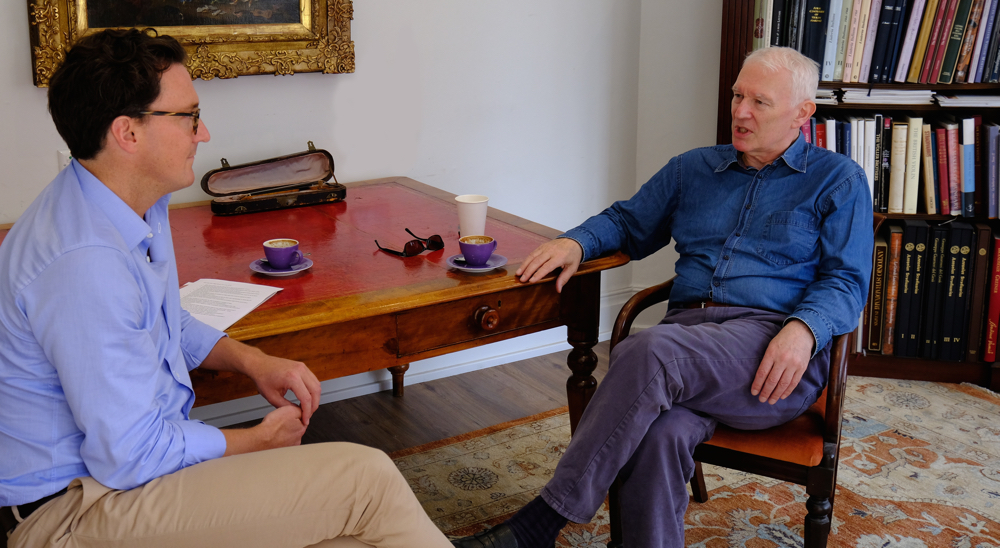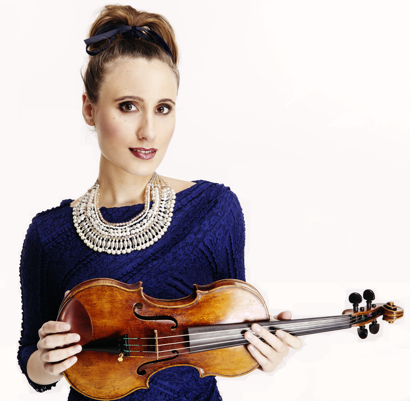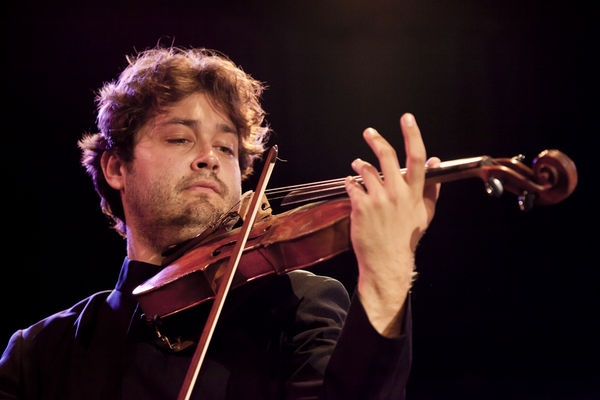Jason Price: The Stradivari Trust has become one of the most successful schemes to help musicians obtain a fine instrument and participate in that investment. Where did the idea come from?
Nigel Brown: It came out of my interest in violins. I started to play the violin at the age of about six and the name Antonio Stradivari had been lodged in my cranial capacity from about that stage.
Eventually I ended up in London working in the stock exchange. And in 1971 Sotheby’s sold the ‘Lady Blunt’, and when I saw that it had made £84,000 my eyes nearly popped out – I thought I’d better start going along to Sotheby’s to see what’s up. So I would go along and have a look at their violins. And I started collecting the catalogues and one or two books, and started getting into all this stuff.
Fastforwarding a bit, I left London and set up my own investment business in Cambridge. And then a connection of mine recommended Nigel Kennedy to come and see me for the mortgage to buy his first house. I met him and I said, ‘Why hasn’t anyone bought you a Strad? And he said, ‘Nobody’s offered, mate.’ So I said, ‘Oh, I’ll find somebody to buy you a Strad.’
JP: So you planted the seed.
NB: He said, ‘Cheers mate’ but he didn’t believe me and after I’d tried in vain for about two years, I was beginning not to believe me. But then one of the clients I’d spoken to early on about the project came and said to me, ‘I’ve got a bit of money, and have been thinking about your violin thing for Nigel Kennedy – is he still in need of an instrument?’ Anyway, it’s long story but eventually I rang up Graham Wells at Sotheby’s and asked if I could bring Nigel Kennedy along. And he said, ‘I’ll keep the shop open for you.’ So we got to Sotheby’s one Friday evening and we had a Strad tasting. We tried three instruments – the [1725] ‘Wilhelmj’, the [1732] ‘Red Diamond’ and the [1721] ‘Lady Blunt’. And we came to the conclusion that the ‘Red Diamond’ was the best of those three for him. But then he met the [1707] ‘Cathédrale’ Strad and that was it – love at first sight.
JP: So then you put a trust together…?
NB: No, this client of mine bought the ‘Cathédrale’ for Nigel. And the deal was that we would create a hundred shares and Nigel would buy at least one a year. So Nigel was saying, ‘It’s going to take me a hundred years’. But he did start buying them.
JP: So that was the idea from the beginning – that it should be a way for the musician to buy shares in the instrument little by little?

After meeting Nigel Kennedy in the 1980s, Brown found him a sponsor to buy the 1707 ‘La Cathédrale’ Stradivari. Two years later, the Stradivari Trust was born
NB: Yes. My contention is that the day that musicians cannot get their hands on these instruments in a meaningful way is the death of the thing. And as soon as I’d done the deal for Nigel I had a queue of musicians outside.
JP: So when was the first syndicated trust?
NB: Within two years of Nigel – for a [1744] Carlo Bergonzi violin that I got for Lorraine McAslan.
JP: And how many investors were there in that syndicate?
NB: Ten.
JP: And what’s the average number of members in these syndicates that you put together?
NB: These days, given the sort of money involved, it’s at least 10 and probably nearer 20. But it might even go as far as 40. [The size of the individual contribution] doesn’t matter to us. I don’t want to challenge these people financially. They say, ‘What’s the minimum investment?’ I say, ‘Well I don’t really like the word investment.’
JP: What word do you prefer?
NB: Contribution.
‘This is not a charitable exercise. You will get to own a bit of the instrument and what’s more the musician will do their best to buy you out’
JP: OK, but it is an investment; they’re going to get it back, right?
NB: Absolutely. This is not a charitable exercise. You will get to own a bit of the instrument and what’s more the musician will do their best to buy you out. But they have to buy you out at the going price.
JP: It strikes me that you’ve done two things. One, you’ve created a tool-kit or a template, with which people can put together these trusts. But you’ve also created a network of potential donors. And the question is which is the more important part for the musician at the moment. Obviously both are important but when they come to you do they want the tool-kit or do they want the access?
NB: Well most of them are not aware that there’s a tool-kit. They just think that there’s this geezer in Cambridge who’s helped a few musicians and can I help them too? So I explain to them how it works. Musicians come in all shapes and sizes. Some of them understand it like crazy. But mostly they are not of that ilk.
JP: You do a lot of hand holding, I imagine. So, I imagine the actual process of raising funds is different for each person. You hold fundraising concerts for some musicians, don’t you?
NB: Yes, I’m an honorary fellow of Hughes Hall [in Cambridge] and you can get 40, 50 people in there. We’re beginning to get a bit of a following. People are surprised they can get involved with the musician in such an intimate way, and they love it. The other evening we were raising money for a [Giovanni Grancino] violin and we raised about 50 grand for it.
JP: So how many musicians are able to make a substantial repurchase of the shares of their instrument?
NB: Well I haven’t done the sums recently – but about two or three years ago, I’d done about 35 schemes and 17 of the musicians had bought out their schemes.
JP: That’s fantastic.
NB: I believe that the musician should own their own instrument. It’s also eventually their pension scheme. It’s an old fashioned idea, but hey you know this is a good thing.
JP: Absolutely. So after you get the syndicate funded and the instrument is purchased, how long does the average syndicate last?
NB: Twenty years.
JP: What happens when an investor wants to leave? Whether it’s a big chunk or a small chunk of the syndicate, how does that work?
NB: They can’t. There’s no liquidity in these things unless the musician creates it.
JP: So how do you determine whose shares get bought out?
‘I believe that the musician should own their own instrument. It’s also eventually their pension scheme. It’s an old fashioned idea, but hey, it’s a good thing’
NB: We have the right to force the whole syndicate to sell some shares to the artist. But we generally don’t work that way. If a musician comes to us with ten grand, we write to all the syndicate members and ask if they are prepared to sell or not. If enough say yes then we don’t have to force the issue. If everybody says no, then we just spread it around equally between all of them.
JP: This brings me to another question. In the past ten years or so, several people have proposed the idea of creating a hedge-fund type vehicle to invest in violins and one of the critiques that I have with this idea is that it would likely have the effect of distorting valuations. One of the great things about the violin market is that it tends to attract people who know something about violins, want them to be used for music-making and are in it for the long-haul. If you throw a bunch of new money into this market, all at once it could really distort the price of things.
NB: Right. They wouldn’t care about the underlying objects – they could be bags of beans as far as they’re concerned.
JP: But your trusts are also a form of a sponsorship, right? It’s not just an investment. You’re actually looking for people who first of all will hear the music, care about it, then see the person playing, care about them and then say, let me help and I’ll also get some long-term benefit.
NB: Yes. One of the reasons that we aren’t subject to regulation by the Financial Services Act is actually that the principal purpose of the scheme is to help the career of the musician. So this is a secured sponsorship. The sponsor puts the money up and helps the musician by buying the tool of the trade secured with the interest in the asset.
JP: And how do you manage that asset once it’s in the syndicate? You have to make sure it’s being handled correctly and properly maintained?
NB: It’s all in the user agreement. The musician will maintain it. The trust insures it but the musician pays the premium. Everything has to be handled through the trust. We make sure it’s insured for its full value at all times. So valuations are done once a year, although actually you’ve got no idea of the real value until you put it out on the market.
JP: So roughly what is the total of assets in the trusts at the moment?
NB: The last time we did a sort of rough valuation of the whole thing, it was about £50 million.
JP: That’s a huge amount! So what’s next? If you could imagine the scheme of the future – what would it be?
NB: Well I think that what’s needed is more of the same, because there’s no question in my mind that I am helping enormously in a part of the marketplace that needs help. Also, I’ve got to the point now where musicians are buying out shares and when I offer the money to the investors they don’t want it back. They say, ‘Have you got something else?’ That obviously helps with the next syndicate. And of course if an instrument gets sold, similarly.
I got a Goffriller violin for a musician a few years ago, and she owned about 50% of it. One member of the syndicate then got in touch with me about 18 months ago and said, ‘I’ve decided that I want to buy all the remaining shares from the scheme because my intention is to give the shares to [the musician].’ Now to manage to trigger such generosity is incredible. I think that shows you how people do get excited about these things.
JP: It’s wonderful to be at the intersection of philanthropy and music.
NB: Yes. So I’m going on doing what I’m doing.
Nigel Brown is Chairman of the Stradivari Trust, which is based in Cambridge, UK.
Beneficiaries of the Stradivari Trust
– Matthew Barley – Giulio Cesare Gigli cello, c. 1760–70
– Daniel Bell – Nicolò Amati violin, c. 1650–84
– Stephen Bryant – Giovanni Pressenda violin, 1831
– Natalie Clein – ‘Simpson’ G.B. Guadagnini cello, 1777
– Jonathan Cohen – Giuseppe Guarneri ‘filius Andreae’ cello, 1712
– Florence Cooke – Bazin violin bow
– Alda Dizdari – Dominique Peccatte violin bow
– Madeleine Easton – Giovanni Grancino violin, 1682
– Lyn Fletcher – Pietro Guarneri of Mantua violin, 1685
– Kate Gould – Carlo Giuseppe Testore cello, 1711
– Jessica Hayes – Giovanni Grancino cello, 1685
– Mary Hofman – James Tubbs violin bow
– Steven Isserlis – Domenico Montagnano cello, 1740
– Guy Johnston – Eugène Sartory cello bow
– Nigel Kennedy – ‘La Cathédrale’ Stradivari violin, 1707; ‘Lafont’ Guarneri ‘del Gesù’ violin, c. 1735
– Helen Kruger – Gagliano violin, 1784
– Gabrielle Lester – Francesco Rugeri violin, 1670
– Lorraine McAslan – Carlo Bergonzi violin, 1744
– John Metcalfe – Giovanni Battista Ceruti violin, 1800
– Graham Mitchell – double bass attributed to the Testore family, c. 1750
– Priya Mitchell – Tommaso Balestrieri violin, 1760
– Krysia Osostowicz – Francisco Gofriller violin, 1720
– Jennifer Pike – Matteo Gofriller violin, 1708
– Lawrence Power – Antonio Brensi viola, c. 1610
– Alex Redington – Carlo Tononi violin, 1708
– Jacqueline Ross – Andrea Amati violin, 1570
– Alicja Smietana – Camillo Camilli violin, 1740
– Sophie Till – Nicolò Gagliano violin, 1732
– Matthew Trusler – ‘Wooldridge’ Stradivari violin, 1711
– Jamie Walton – Giuseppe Guarneri ‘filius Andreae’ cello, 1712
– Christopher Warren-Green – Guarneri violin, 1746
– Diana Yukawa – Giuseppe Dall’Aglio violin, c. 1810


